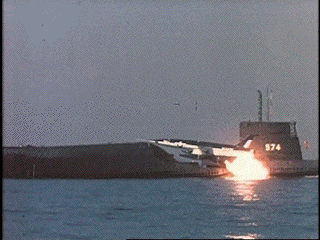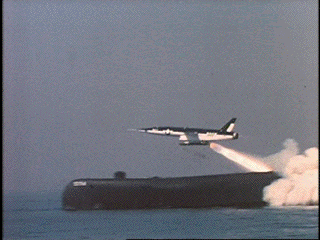Flightdeck Friday – The Regulus I and II
 It’s May 1947 and you, as a senior service see that the new upstart service has taken over an Army order for a turbojet powered, unmanned missile that will be capable of carrying a nuclear warhead. What do you do? You go out and place a similar order with a competitor.
It’s May 1947 and you, as a senior service see that the new upstart service has taken over an Army order for a turbojet powered, unmanned missile that will be capable of carrying a nuclear warhead. What do you do? You go out and place a similar order with a competitor.
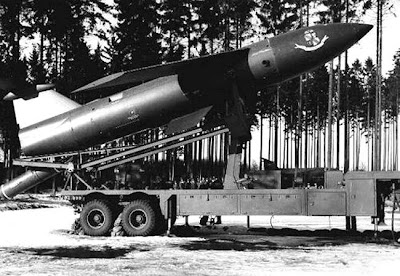 In October 1943, Chance Vought signed a study contract for a 300-mile range pilotless missile that carried a 4,000-pound warhead. But little transpired until the soon-to-be-separated AAF provided the impetus for the Navy Program. In May 1947, the Army awarded Martin a contract for a turbojet-powered subsonic missile which became the Matador. The Navy saw this as a threat to its role in guided missiles and, within days, ordered BuAer to start a similar Navy missile that could be launched from a submarine, using the same engine as the Matador (J33) and components on hand. By August 1947, the project had gained both a name (Regulus) and performance requirements. The Navy wanted the missile to carry a 3,000-pound warhead to a maximum range of 500 nm at Mach .85 with a CEP of .5 percent of the range. The vehicle would be 30 feet in length, 10 feet in span, 4 feet in diameter, and would weigh between 10,000 and 12,000 pounds.
In October 1943, Chance Vought signed a study contract for a 300-mile range pilotless missile that carried a 4,000-pound warhead. But little transpired until the soon-to-be-separated AAF provided the impetus for the Navy Program. In May 1947, the Army awarded Martin a contract for a turbojet-powered subsonic missile which became the Matador. The Navy saw this as a threat to its role in guided missiles and, within days, ordered BuAer to start a similar Navy missile that could be launched from a submarine, using the same engine as the Matador (J33) and components on hand. By August 1947, the project had gained both a name (Regulus) and performance requirements. The Navy wanted the missile to carry a 3,000-pound warhead to a maximum range of 500 nm at Mach .85 with a CEP of .5 percent of the range. The vehicle would be 30 feet in length, 10 feet in span, 4 feet in diameter, and would weigh between 10,000 and 12,000 pounds.
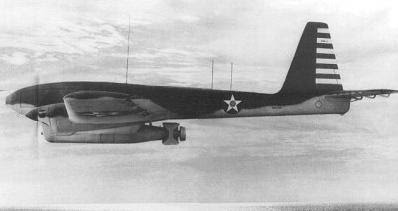 A parallel arc on Navy’s side was the advocacy and development of pilotless drones under the leadership of Captain Fahrney. Widely regarded as the father of the Navy’s guided missile program, during WW2 he had developed and tested a pilotless torpedo drone, the TDR-1 under Project Option, successfully demonstrating a remotely launched torpedo attack against the USS Aaron Ward (ed: In a footnote, the TDR was built by the Wurlitzer Musical Instrument Company – yes that one, of piano and organ fame. If you have to make a lot of something out of wood and to exacting precision, who better than a piano firm in the early-mid 1940’s?). While the TDR was overcome by progress in the Pacific, the skills and capabilities demonstrated by the crews flying the drones from accompanying Avengers would come in handy later, as the reader shall see.
A parallel arc on Navy’s side was the advocacy and development of pilotless drones under the leadership of Captain Fahrney. Widely regarded as the father of the Navy’s guided missile program, during WW2 he had developed and tested a pilotless torpedo drone, the TDR-1 under Project Option, successfully demonstrating a remotely launched torpedo attack against the USS Aaron Ward (ed: In a footnote, the TDR was built by the Wurlitzer Musical Instrument Company – yes that one, of piano and organ fame. If you have to make a lot of something out of wood and to exacting precision, who better than a piano firm in the early-mid 1940’s?). While the TDR was overcome by progress in the Pacific, the skills and capabilities demonstrated by the crews flying the drones from accompanying Avengers would come in handy later, as the reader shall see.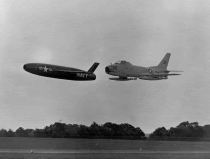 CONOPS for Regulus I called for launches from either surfaced submarines (for an exceptional background story on the development of this capability starting with the Loon, head over to EagleSpeak’s 21 Jan article (http://eaglespeak.blogspot.com/)) or launched from carriers or cruisers. Guidance was via radio control, exercised from either up to two submarines along the flight path or via accompanying aircraft (at first the F6F Hellcat, later the TV-2 and FJ were used). Guidance could not, however, be passed from one surface platform to another – from a submarine say to a cruiser.
CONOPS for Regulus I called for launches from either surfaced submarines (for an exceptional background story on the development of this capability starting with the Loon, head over to EagleSpeak’s 21 Jan article (http://eaglespeak.blogspot.com/)) or launched from carriers or cruisers. Guidance was via radio control, exercised from either up to two submarines along the flight path or via accompanying aircraft (at first the F6F Hellcat, later the TV-2 and FJ were used). Guidance could not, however, be passed from one surface platform to another – from a submarine say to a cruiser.
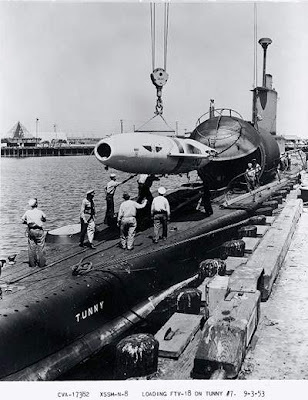 Before the Regulus even flew though, it had to run a gauntlet raised by the new Department of
Before the Regulus even flew though, it had to run a gauntlet raised by the new Department of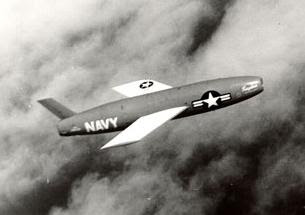 Defense which took a dim view of two similar weapons being developed by different services. Forced to justify the Regulus in light of the Matador’s lead in development, the Navy emphasized the inherent operational flexibility (Regulus needed only two control points vs. the Matador’s three and it could be stored with it’s boosters attached vice the Matador’s requirement to have the booster added after it was on the
Defense which took a dim view of two similar weapons being developed by different services. Forced to justify the Regulus in light of the Matador’s lead in development, the Navy emphasized the inherent operational flexibility (Regulus needed only two control points vs. the Matador’s three and it could be stored with it’s boosters attached vice the Matador’s requirement to have the booster added after it was on the 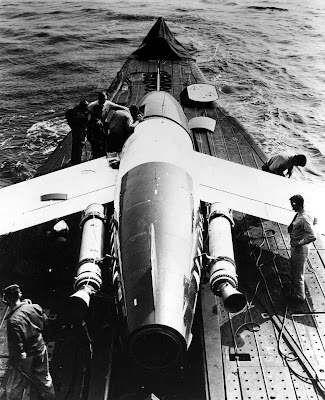 launcher) coupled with procurement of recoverable training missiles as proof of overall system economy. Allowed to proceed with development, the first Regulus I flew in March 1951 and was followed by the first launch from a submarine, the USS Tunny in July 1953. Continued problems with the guidance section and radio controls, among other things, delayed the operational introduction of the Regulus until 1955.
launcher) coupled with procurement of recoverable training missiles as proof of overall system economy. Allowed to proceed with development, the first Regulus I flew in March 1951 and was followed by the first launch from a submarine, the USS Tunny in July 1953. Continued problems with the guidance section and radio controls, among other things, delayed the operational introduction of the Regulus until 1955.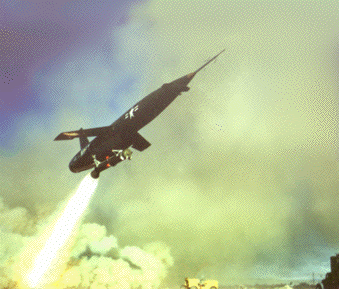 While the Regulus I patrols began, work was already underway on its replacement — the Regulus II. Concern that the Regulus I had too many vulnerabilities (speed, reliance on external guidance, time spent on the surface by the sub, etc.) led to Navy signing C-V to build a supersonic variant, one that would fly at 60,000 ft and Mach 2+. Following the model of the Regulus I program, C-V over-engineered the structural strength of the Reg II and started with most of the first production batch as recoverable drones. The Reg II would be guided by the (then) new inertial guidance system and would be launched from a new class of submarine, led by the Growler. First flight of the Reg II was barely 1 year after the Reg I went operational, May 1956 and on Sept 15, 1958 the first operational test launch took place off the Grayback. Control was picked up by the chase plane, a TV-2/T-33 and it headed towards its destination at Edwards AFB. Along the way, control was passed off to Pt. Mugu then finally Edwards itself. The flight was successful until the final moments after landing when it burst into flame after having to make a wheels up landing when the gea would not extend. By the endof the year a total of 48 successful flights had been accomplished including launches from a converted LST. In December 1958, however, inspite of the successful threshold the Reg II stood upon, Thomas Gates, SecNav, cancelled the program (a move ADM Zumwalt would later call one of the worst decisions he had seen). The reason was the Polaris SLBM program was stunningly successful and represented a quantum leap ahead in capability and survivability — the Reg II had been the ace-in-the-hole in case Polaris did not pan out. The Regulus finished its days as a target drone with the last of the program closing down in 1968. Despite the promise shown by the Regulus family, it would be decades later before the Navy was back in the cruise missile business again, this time with Harpoon and Tomahawk.
While the Regulus I patrols began, work was already underway on its replacement — the Regulus II. Concern that the Regulus I had too many vulnerabilities (speed, reliance on external guidance, time spent on the surface by the sub, etc.) led to Navy signing C-V to build a supersonic variant, one that would fly at 60,000 ft and Mach 2+. Following the model of the Regulus I program, C-V over-engineered the structural strength of the Reg II and started with most of the first production batch as recoverable drones. The Reg II would be guided by the (then) new inertial guidance system and would be launched from a new class of submarine, led by the Growler. First flight of the Reg II was barely 1 year after the Reg I went operational, May 1956 and on Sept 15, 1958 the first operational test launch took place off the Grayback. Control was picked up by the chase plane, a TV-2/T-33 and it headed towards its destination at Edwards AFB. Along the way, control was passed off to Pt. Mugu then finally Edwards itself. The flight was successful until the final moments after landing when it burst into flame after having to make a wheels up landing when the gea would not extend. By the endof the year a total of 48 successful flights had been accomplished including launches from a converted LST. In December 1958, however, inspite of the successful threshold the Reg II stood upon, Thomas Gates, SecNav, cancelled the program (a move ADM Zumwalt would later call one of the worst decisions he had seen). The reason was the Polaris SLBM program was stunningly successful and represented a quantum leap ahead in capability and survivability — the Reg II had been the ace-in-the-hole in case Polaris did not pan out. The Regulus finished its days as a target drone with the last of the program closing down in 1968. Despite the promise shown by the Regulus family, it would be decades later before the Navy was back in the cruise missile business again, this time with Harpoon and Tomahawk.
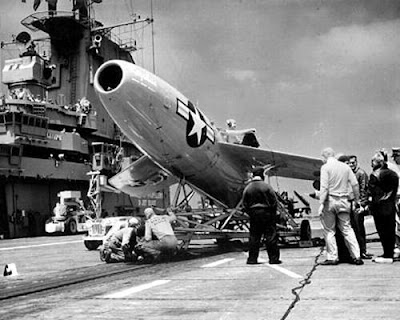
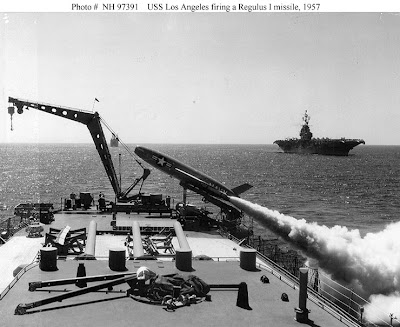 General Specifications
General Specifications
Fuselage Diameter: 56.5 in (1.4 m)
Fuselage Length: 386 in (9.8 m)
Wingspan: 252 in (6.4 m) extended, 118.5 in (3.0 m) folded
Wing Depth: 76 in (1.9 m)
Overall Height: 92.3 in (2.3 m)
Overall Length: 498.7 in (12.7 m)
Warhead: 3000 lb (1,360 kg) such as the W5 warhead or the W27 warhead
Weight at launch: 13,685 lb (6,207 kg)


